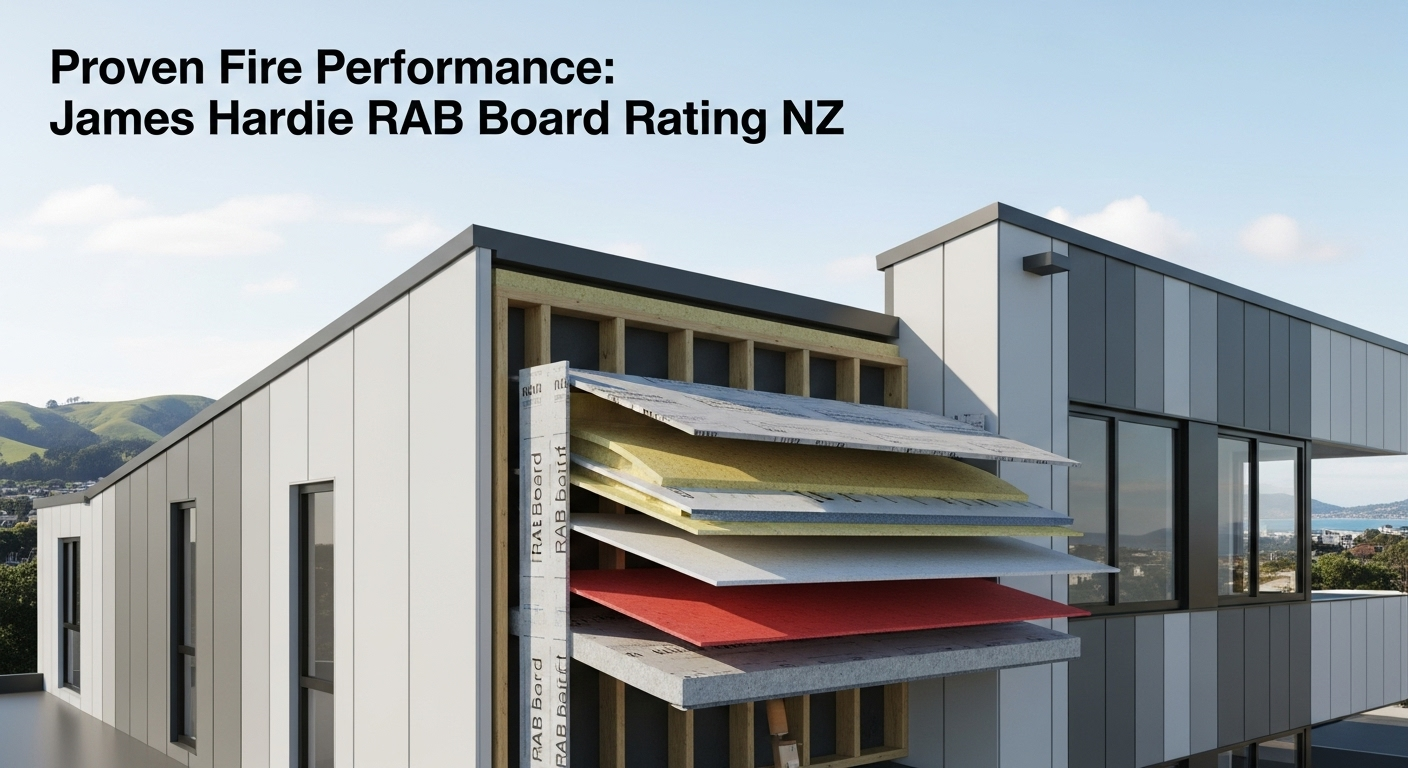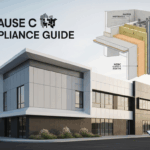Understanding the Critical Role of Fire-Resistant Materials in NZ Construction
Proven Fire Performance – The New Zealand Building Code (NZBC) sets out clear and stringent requirements for fire safety in buildings. Clauses C1 to C6, “Protection from Fire,” dictate how buildings must be designed and constructed to safeguard people from injury and illness, protect other properties from damage, and facilitate firefighting and rescue operations. Achieving compliance requires a holistic approach, where individual components contribute to the overall passive fire protection system of a building.
Passive fire protection is a vital concept in this framework. It involves using building components and systems that are designed to contain a fire or slow its spread, allowing occupants time to escape and emergency services to intervene. This is achieved through fire-resistant walls, floors, and ceilings. The materials used in these assemblies are rigorously tested and rated for their ability to withstand fire, and this is where the choice of products like James Hardie RAB Board becomes critically important. A material’s inherent fire resistance can significantly impact the effectiveness and efficiency of the entire fire safety system.

James Hardie RAB Board: A Foundation of Resilience
James Hardie RAB Board is an advanced fibre cement sheet used as a rigid air barrier. It is fixed to the exterior of the building frame, creating a robust, secondary line of defence against weather intrusion before the final cladding is installed. However, its purpose and benefits extend far beyond simple weatherproofing, making it a multifaceted solution for modern building envelopes.
The Composition and Technology Behind RAB Board
The exceptional performance of RAB Board stems from its unique composition. It is manufactured from a durable mix of Portland cement, ground sand, cellulose fibre, and water. This fibre cement composition is the key to its inherent strength, durability, and, most importantly, its resistance to fire.
Furthermore, RAB Board features a distinctive green panel that is sealed with James Hardie’s innovative CoreShield™ penetrating sealer technology. This treatment provides superior water resistance, effectively reducing the risk of moisture absorption and subsequent damage to the framing. The panels are then installed with vapour permeable tape over the joints, creating a continuous, breathable air and water barrier that enhances the building’s overall thermal performance and long-term durability.
More Than Just a Weather Barrier: Multifunctional Benefits
While its role as an air and water barrier is primary, RAB Board offers several other key advantages. It provides excellent structural bracing, contributing to the rigidity and stability of the building frame, which is particularly valuable in New Zealand’s seismically active environment. Its density also lends it impressive acoustic properties, helping to reduce the transmission of external noise for a quieter interior environment.
This combination of weather resistance, structural integrity, acoustic insulation, and fire safety makes it an incredibly efficient and effective product. It streamlines the construction process by fulfilling multiple performance requirements with a single, reliable material, a significant advantage for project timelines and budgets.
The Core Advantage: Non-Combustibility
The most critical feature concerning fire safety is the material’s non-combustibility. Unlike timber-based sheathings such as plywood or Oriented Strand Board (OSB), which are inherently combustible, James Hardie RAB Board will not burn. It does not ignite when exposed to flame and will not contribute fuel to a fire.
This characteristic is fundamental to its role in fire-rated systems. A non-combustible sheathing provides a stable and predictable foundation for building fire-resistant wall assemblies. It ensures that the sheathing layer itself will not become a point of failure or accelerate the spread of flames, which is a crucial consideration for the rab board fire rating james hardie systems achieve.
Deciphering the RAB Board Fire Rating James Hardie Offers
When discussing fire ratings in New Zealand, it’s essential to understand the specific metrics used to classify performance. The performance of RAB Board is not just a vague claim; it is backed by rigorous testing and quantifiable ratings that align directly with the NZBC. The rab board fire rating james hardie provides is a testament to its engineering and composition.
Key Fire Performance Metrics in New Zealand
Two primary metrics are crucial for understanding a product’s fire performance in the context of the NZBC:
- Fire Resistance Rating (FRR): This rating applies to a complete building assembly (e.g., a wall, floor, or ceiling system) and measures its ability to withstand a fully developed fire. The FRR is expressed in minutes and consists of three numbers:
- Stability: The ability of the assembly to maintain its load-bearing capacity during a fire. (Represented by a number, or a ‘-‘ if non-load-bearing).
- Integrity: The ability of the assembly to prevent the passage of flames and hot gases.
- Insulation: The ability of the assembly to limit the temperature rise on the non-fire side.
- An example rating might be
60/60/60for a load-bearing wall, or-/60/60for a non-load-bearing wall.
- Group Number Classification: This rating applies to the surface finish of a material and indicates its contribution to fire spread. Materials are classified into Groups 1 through 4, based on their performance in a standard fire test (ISO 9705).
- Group 1: Materials with the best fire performance (lowest fire spread and heat release).
- Group 4: Materials with the poorest fire performance (highest fire spread).
- A suffix ‘S’ (e.g., 1-S) indicates low smoke production.
The Specifics: James Hardie RAB Board Fire Ratings
James Hardie provides comprehensive technical literature detailing the fire performance of systems incorporating RAB Board. It is crucial to remember that the FRR is for the entire system, not the board in isolation. The performance depends on the combination of framing, insulation, internal linings (like GIB Fyreline®), and the RAB Board itself.
Fire Resistance Ratings (FRR) for Wall Assemblies
James Hardie has tested various wall assemblies to determine their FRRs, providing architects and builders with proven solutions for fire safety compliance. When used as part of a specified and correctly installed system, RAB Board contributes to achieving impressive fire resistance.
- Timber Framed Walls: For typical timber-framed external walls, systems incorporating 9mm RAB Board, appropriate insulation (such as glass wool), and specified internal plasterboard linings can achieve FRRs of up to -/60/60. This means the wall maintains its integrity and insulation for at least 60 minutes in a fire, preventing fire spread for a critical period.
- Steel Framed Walls: In steel-framed construction, similar fire-rated systems are available. By combining 9mm RAB Board on the exterior with steel framing, cavity insulation, and fire-rated plasterboard on the interior, builders can achieve a 60-minute Fire Resistance Rating. These systems are detailed in James Hardie’s Fire and Acoustic Design Manual, providing clear guidance for specification. The excellent rab board fire rating james hardie offers is a direct result of this system-based approach.
Group Number Classification for Surface Finishes
In addition to its role within FRR assemblies, the surface of the RAB Board itself has been tested for its reaction to fire. James Hardie RAB Board has achieved a Group Number Classification of 1-S.
This is the highest possible rating, signifying that it has very low rates of heat release and smoke production, and it limits the spread of flame across its surface. This 1-S rating makes it suitable for use in the most critical areas of a building, including exit ways, corridors, and atriums, where controlling fire spread and maintaining visibility for evacuation is essential. This superior surface fire property further solidifies the credentials of the rab board fire rating james hardie provides to the market.
Practical Applications and Compliance with the NZ Building Code
The proven fire performance of James Hardie RAB Board translates into tangible benefits and practical applications across a wide range of building projects in New Zealand. Its ratings allow designers to confidently specify it in situations where fire safety is a primary design constraint.
Inter-tenancy Walls and Multi-Residential Buildings
In terraced housing, apartments, and other multi-unit developments, preventing fire spread between adjoining dwellings is a legal and moral imperative. The NZBC has specific, demanding requirements for inter-tenancy walls. Systems incorporating RAB Board are frequently specified to create fire-rated boundary walls that not only meet but exceed these minimum requirements, providing enhanced safety for residents. The reliable rab board fire rating james hardie engineers have developed is invaluable in these high-stakes applications.
Buildings on or Near Boundaries
For standalone homes and commercial buildings constructed close to a property boundary, there is a significant risk of fire spreading from one building to another. The NZBC requires external walls near a boundary to have a specific fire rating to mitigate this risk. Using a fire-rated wall assembly featuring RAB Board provides a compliant and effective solution, protecting both the building and its neighbours.
Streamlining the Construction Process
The use of RAB Board can also offer logistical advantages. Because it can be exposed to the elements for up to 180 days (subject to conditions), it allows the building to be enclosed and made weathertight early in the construction process. This enables interior trades to begin work sooner, regardless of the weather, improving project efficiency. Knowing that this same product also forms a critical part of the final fire-rated wall system adds another layer of efficiency, reducing the need for multiple complex materials.
Ensuring Compliance Through Correct Installation
To achieve the specified rab board fire rating, James Hardie technical literature must be followed precisely. Fire-rated systems are highly engineered, and their performance is contingent on correct installation. This includes using the specified framing, insulation, cavity battens, fixings, and internal linings. Any deviation from the tested system can compromise the FRR and invalidate compliance. Builders and installers must ensure they are working from the latest James Hardie Fire and Acoustic Design Manual to guarantee the assembly is constructed as tested and intended.
Conclusion
In the pursuit of creating safer, more resilient buildings for New Zealand, material choice is everything. James Hardie RAB Board stands as a premier example of a product that delivers on multiple fronts, offering exceptional performance as a rigid air barrier while providing a formidable defence against fire. Its non-combustible fibre cement composition is the bedrock of its safety credentials, ensuring it will not contribute to a fire’s growth.
The specific and proven rab board fire rating james hardie has achieved through rigorous system testing provides architects and builders with the confidence to meet and exceed the New Zealand Building Code’s stringent fire safety requirements. With the ability to contribute to systems with a 60-minute Fire Resistance Rating and boasting a top-tier Group 1-S surface finish classification, RAB Board is more than just a component; it is a comprehensive safety solution. By integrating this high-performance board into building envelopes, the industry can continue to construct durable, weathertight, and, most importantly, fire-safe buildings for generations to come.






